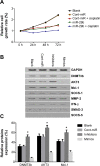Micro-ribonucleic acid 29b inhibits cell proliferation and invasion and enhances cell apoptosis and chemotherapy effects of cisplatin via targeting of DNMT3b and AKT3 in prostate cancer
- PMID: 25784815
- PMCID: PMC4356695
- DOI: 10.2147/OTT.S76484
Micro-ribonucleic acid 29b inhibits cell proliferation and invasion and enhances cell apoptosis and chemotherapy effects of cisplatin via targeting of DNMT3b and AKT3 in prostate cancer
Abstract
Background: Micro-ribonucleic acids (miRNAs) are crucial regulators in malignant tumors. miRNA-29b (miR-29b) has been identified as a tumor suppressor in prostate cancer (PCa). However, very few studies have investigated the effects of miR-29b in PCa, especially the mechanism and its association with chemotherapy. Our study aimed to explore the role and mechanism of miR-29b in PCa.
Materials and methods: The expression levels of miR-29b were detected in ten clinical PCa specimens and four different PCa cell lines through quantitative real-time polymerase chain reaction. After miR-29b mimics and inhibitors were successfully transfected into LNCaP, the 3-(4,5-dimethylthiazol-2-yl)-2,5-diphenyltetrazolium bromide assay was then used to investigate cell proliferation and cisplatin sensitivity of PCa cells. Cell cycle, cell apoptosis, and cell invasion were detected via flow cytometry, annexin V-fluorescein isothiocyanate labeling, and transwell assay, respectively. Based on bioinformatic methods, Western blot analysis, and dual-luciferase reporter assay, novel target genes of miR-29b were identified.
Results: miR-29b was downregulated in PCa tissues compared with matched adjacent nontumor tissues. In the androgen-independent PCa cell line (LNCaP-AI), the expression of miR-29b was much lower than the androgen-dependent PCa cell line (LNCaP). Subsequent studies showed that forced expression of miR-29b inhibited cell proliferation and cell invasion and induced cell apoptosis in PCa. Upregulation of miR-29b also enhanced the chemosensitivity of PCa cells to cisplatin. Moreover, we identified DNMT3b and AKT3 as novel target genes of miR-29b in PCa.
Conclusion: Taken together, the results showed that miR-29b plays a tumor-suppressive role in PCa. It inhibits cell biological behavior and enhances the chemotherapy effects of cisplatin through its involvement in epigenetic regulation and PI3K/AKT pathway.
Keywords: AKT3; DNMT3b; cell biological behavior; chemosensitivity; miRNA-29b; prostate cancer.
Figures




Similar articles
-
Role of gga-miR-29b-3p in suppressing the proliferation, invasion and migration of MSB1 Marek's disease tumor cells by the targeting of the DNMT3B gene.Ann Transl Med. 2022 Aug;10(16):873. doi: 10.21037/atm-22-3519. Ann Transl Med. 2022. PMID: 36110994 Free PMC article.
-
miR-29b-3p inhibits 22Rv1 prostate cancer cell proliferation through the YWHAE/BCL-2 regulatory axis.Oncol Lett. 2022 Jul 1;24(2):289. doi: 10.3892/ol.2022.13409. eCollection 2022 Aug. Oncol Lett. 2022. PMID: 35928803 Free PMC article.
-
miR-128 modulates chemosensitivity and invasion of prostate cancer cells through targeting ZEB1.Jpn J Clin Oncol. 2015 May;45(5):474-82. doi: 10.1093/jjco/hyv027. Epub 2015 Mar 25. Jpn J Clin Oncol. 2015. PMID: 25921099
-
Role of miR-489 in the proliferation and apoptosis of pancreatic carcinoma.J BUON. 2019 Jul-Aug;24(4):1574-1580. J BUON. 2019. PMID: 31646811
-
Mir-29b in Breast Cancer: A Promising Target for Therapeutic Approaches.Diagnostics (Basel). 2022 Sep 2;12(9):2139. doi: 10.3390/diagnostics12092139. Diagnostics (Basel). 2022. PMID: 36140539 Free PMC article. Review.
Cited by
-
Gene interference strategies as a new tool for the treatment of prostate cancer.Endocrine. 2015 Aug;49(3):588-605. doi: 10.1007/s12020-015-0629-3. Epub 2015 Jun 7. Endocrine. 2015. PMID: 26049369 Review.
-
Fucoidan Elevates MicroRNA-29b to Regulate DNMT3B-MTSS1 Axis and Inhibit EMT in Human Hepatocellular Carcinoma Cells.Mar Drugs. 2015 Sep 24;13(10):6099-116. doi: 10.3390/md13106099. Mar Drugs. 2015. PMID: 26404322 Free PMC article.
-
MicroRNAs and epithelial-mesenchymal transition in prostate cancer.Oncotarget. 2016 Oct 11;7(41):67597-67611. doi: 10.18632/oncotarget.11708. Oncotarget. 2016. PMID: 27588490 Free PMC article. Review.
-
Interactions between anticancer active platinum complexes and non-coding RNAs/microRNAs.Noncoding RNA Res. 2016 Oct 13;2(1):1-17. doi: 10.1016/j.ncrna.2016.10.001. eCollection 2017 Mar. Noncoding RNA Res. 2016. PMID: 30159416 Free PMC article. Review.
-
Identification of apoptosis-related key genes and the associated regulation mechanism in thoracic aortic aneurysm.BMC Cardiovasc Disord. 2023 Sep 28;23(1):481. doi: 10.1186/s12872-023-03516-0. BMC Cardiovasc Disord. 2023. PMID: 37770840 Free PMC article.
References
LinkOut - more resources
Full Text Sources
Other Literature Sources
Molecular Biology Databases

